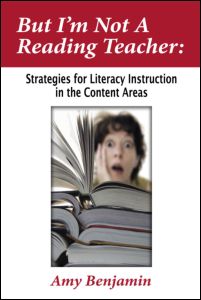But I’m Not a Reading Teacher: Strategies for Literacy in Content Areas
But I’m Not a Reading Teacher: Strategies for Literacy Instruction in the Content Areas
By Amy Benjamin
(Eye on Education/Routledge, 2007 – Learn more)

If you are a content area teacher who has been known to think – or even say out loud – “I’m a _____ teacher, not a reading teacher,” then Amy Benjamin’s But I’m Not a Reading Teacher: Strategies for Literacy Instruction in the Content Areas is a must read. The book’s four parts provide examples, strategies, and practical applications for all teachers. Additionally, at www.amybenjamin.com, teachers will find more activities and classroom ready ideas for literacy instruction. Dr. Benjamin’s suggested strategies are sensible and easy for a busy teacher to implement.
What’s in the book

The second major topic she addresses is Scaffolding Vocabulary Instruction. Teachers should find this particularly useful as they implement the Common Core State Standards (CCSS). She presents six scenarios to clarify what scaffolding is and is not. Benjamin advocates teaching Latin and Greek word components to help students become fluent readers of academic text. (Yet another CCSS connection!) When writing about standardized testing and comprehension, she places reading comprehension questions in six categories. She provides an example of each along with an analysis of the question/answer.
Part II, Academic Genres, deals with the issues surrounding the language and comprehension demands of content- specific courses (e.g., math, business, technology, science, social studies, languages other than English, and English Language Arts). Benjamin discusses the kind of reading expected in a particular class, provides sample text, and offers insights into where and why students might have comprehension problems. Her suggestions for helping struggling students deal with content-specific vocabulary and reading demands are very teacher-friendly and will be easy to put into practice. In light of the literacy demands of the CCSS, teachers should find this beneficial.
Before, during, and after reading strategies
In Part III, The Strategies, her advice is to “select just one strategy for a segment of text.” She offers practical suggestions on how much time to spend on a strategy and how to reinforce a strategy. She places the strategies into three groups: before-reading, during-reading, and after-reading. Benjamin encourages readers to make use of their team to help students see connections across the content areas. Before-reading strategies include Establishing a Purpose for Reading, Previewing to Determine Importance and Establish Expectations, and Activating Background Knowledge. The reader will find an explanation, examples, and mini-lessons modeling each strategy.
The during-reading strategies work with the before-reading strategies to help readers make meaning of the text. The author addresses three during-reading strategies: Recognizing Textual Pattern Clusters, Visualizing and Animating, and Making Connections. Also included are graphic organizers for each strategy. Using the graphic organizers throughout the building would benefit both students and teachers. The author reminds us that comprehension is taking place as students learn to recognize text patterns. She includes these four pattern clusters:
| Textual Pattern Clusters | Graphic Organizers |
| Pattern Cluster 1: Narrative and Descriptive | 2 |
| Pattern Cluster 2: Classification, Definition, Exemplification | 3 |
| Pattern Cluster 3: Cause and Effect and Comparison/Contrast | 2 |
| Pattern Cluster 4: Process Analysis (Sequence) | 1 |
Page 124 features some guiding questions to help students think about text structure in order to extract meaning. These during-reading strategies keep readers engaged in text. Example texts and mini-lessons for the during-reading strategies are included. The author offers suggestions for teaching visualization in science, math, and social studies.
After-Reading Strategies require “meaning-making activities such as conversation, creative dramatics, writing, or making a visual organizer.” (p. 141) Dr. Benjamin refers to these as Wrap-Up Activities. They focus on main idea, supportive details, vocabulary in context, inferences, and internal organization. This section concludes with ideas on Formative and Summative Reading Assessment with examples from social studies, Latin, science, English Language Arts, and math.
A good book for faculty study
Using a rating system designed by the National Council Teachers of English (NCTE) Commission on Reading, the author addresses a variety of school-wide programs. This last chapter, “What Works? What Doesn’t?”, will help educators achieve the results in their content area.
But I’m Not a Reading Teacher: Strategies for Literacy Instruction in the Content Areas shows content teachers how to focus on reading comprehension with their subject material. This would be an excellent choice for a school-wide book study.
Anne Anderson finally got out of the 8th grade after 24 years and 9 weeks. She spent the next 9 years sharing her expertise in literacy and writing with K-12 teachers and administrators throughout the district. She credits National Writing Project and Poetry Alive! as turning points in her growth as a teacher. She now shares her expertise nationwide as an Educational Consultant and through her website and her bi-monthly newsletter, Spotlight on Success.

































